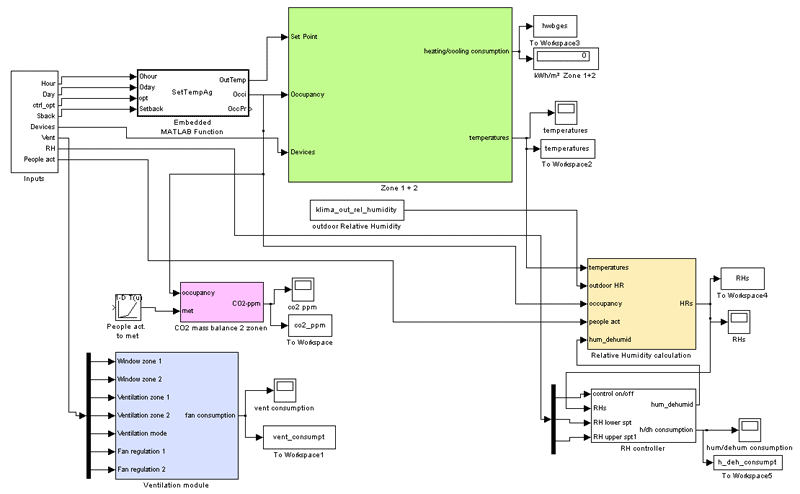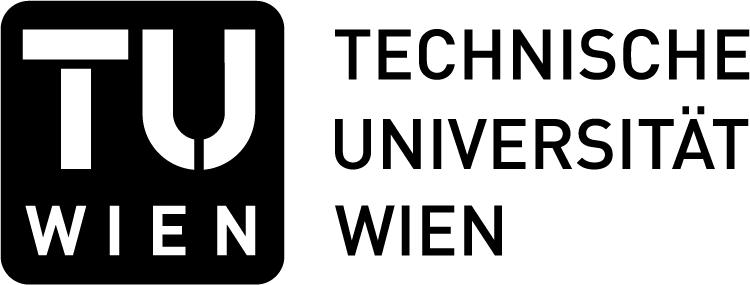The evaluation of the results and improvements obtained in the ThinkHome project are mainly carried out by means of simulations under MATLAB/Simulink, specifically with HAMLab and RTU building models. Short explanation about these terms are mentioned below (Glossary).

Part of the RTU model (beta version)
Most of the current avaliable building models and energy simulation tools are not complete or open enough for the requirements of the ThinkHome project scope. User effect and behaviour simulation and the capability of linking and applying advanced control strategies are some of the usual lacks that justify the development of our own testbed environment. The infrastructure of the project demands an absolutely accesible tool from a high-compatible platform like Java.
The thermodynamic equations and models deployed in RTU as a basis are widely explained in the degree thesis writen by Richard Hofer [1]. Further improvements have been carried out using ASHRAE recomendations for the desing of moisture loads [2].
· Publications:
The next publications have been carried out using HAMLab or/and RTU models in the development of the tests.
-Christian Reinisch, Mario J. Kofler, Felix Iglesias, and Wolfgang Kastner. ThinkHome: Energy Efficiency in Future Smart Homes. EURASIP Journal on Embedded Systems, 2011:18, 2011. [ bib | .pdf ]
-Félix Iglesias Vázquez and Wolfgang Kastner. Clustering methods for occupancy prediction in smart home control. In Industrial Electronics (ISIE'11), IEEE International Symposium on, pp. 1321-1328, 27-30 June 2011. [ DOI ]
-Félix Iglesias Vázquez, Wolfgang Kastner and Christian Reinisch. Impact of user habits in smart home control. Emerging Technologies & Factory Automation (ETFA), 2011 IEEE 16th Conference on, pp. 1-8, 5-9 Sept. 2011. [ DOI ]
· Glossary:
-A computer simulation, a computer model, or a computational model is a computer program, or network of computers, that attempts to simulate an abstract model of a particular system. Computer simulations have become a useful part of mathematical modeling of many natural systems in physics (computational physics), astrophysics, chemistry and biology, human systems in economics, psychology, social science, and engineering. Simulations can be used to explore and gain new insights into new technology, and to estimate the performance of systems too complex for analytical solutions [3].
-MATLAB® is a high-level technical computing language and interactive environment for algorithm development, data visualization, data analysis, and numeric computation. You can use MATLAB in a wide range of applications, including signal and image processing, communications, control design, test and measurement, financial modeling and analysis, and computational biology. MATLAB provides a number of features for documenting and sharing your work. You can integrate your MATLAB code with other languages and applications, and distribute your MATLAB algorithms and applications [4].
-Simulink® is an environment for multidomain simulation and Model-Based Design for dynamic and embedded systems. It provides an interactive graphical environment and a customizable set of block libraries that let you design, simulate, implement, and test a variety of time-varying systems, including communications, controls, signal processing, video processing, and image processing. Simulink is integrated with MATLAB®, providing immediate access to an extensive range of tools that let you develop algorithms, analyze and visualize simulations, create batch processing scripts, customize the modeling environment, and define signal, parameter, and test data [5].
-HAMLab (Heat, Air and Moisture simulation Laboratory) is basically a collection of tools for the development and evaluation of an integrated heat, air and moisture simulation environment for modeling and simulating dynamic heat, air and moisture processes in buildings and systems. All models are implemented in the computational software package MatLab with the use of SimuLink and Comsol [6].
-Java® is a programming language that derives much of its syntax from C and C++ but has a simpler object model and fewer low-level facilities. Java applications can run on any Java Virtual Machine (JVM) regardless of computer architecture. Java is a general-purpose, concurrent, class-based, object-oriented language that is specifically designed to have as few implementation dependencies as possible. It is intended to let application developers "write once, run anywhere" [7].
· References:
[1]: Richard Hofer (Diploma Thesis). Untersuchung des Einflusses von Regelungsstrategien auf den Heizwärmebedarf und die operative Raumtemperatur bei unterschiedlichen Gebäudestandards. [link]
[2]: Tenwolde, A; Walker, I.S. Interior Moisture Design Loads for Residences. Proceedings of the ASHRAE/DOE/BTECC Thermal Performance of Exterior Envelopes of Whole Buildings VIII, Clearwater Beach, FL, ASHRAE, Atlanta, GA (2001). [link]
[3]: Wikipedia: Computer Simulation, http://en.wikipedia.org/wiki/Computer_simulation
[4]: MathWorks: Matlab Introduction, http://www.mathworks.com/products/matlab/description1.html
[5]: MathWorks: Simulink Introduction, http://www.mathworks.com/products/simulink/description1.html
[6]: Schijndel, A.W.M. van (2007). Integrated heat air and moisture modeling and simulation. Eindhoven: Technische Universiteit, PhD thesis, 200 pages. [link1 | link2]
[7]: Wikipedia: Java (programming language), http://en.wikipedia.org/wiki/Java_(programming_language)

